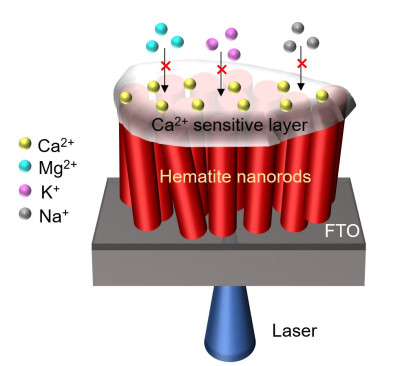News
Hematite nanorods – a promising material for photoelectrochemical sensing and imaging
10 November 2022

Hydrothermally grown hematite nanorods have been shown to be an excellent substrate for photoelectrochemical imaging and sensing.
The material displayed enhanced photocurrent compared to hematite films, good stability, excellent spatial resolution and good sensitivity to pH. Coupling the hematite nanorods with a thin calcium ion selective PVC membrane, we obtained an ion detector with a novel amperometric detection principle and good selectivity over Na+, K+ and Mg2+. The large surface area of the sensor substrate resulted in improved adhesion of the PVC membrane and, hence, stability compared to conventional ion selective sensors. The imaging sensor has great potential for the detection of extracellular calcium in cell culture in the future.
The article “Photoelectrochemical detection of calcium ions based on hematite nanorod sensors” (Authors Bo Zhou, Yunlu Jiang, Qian Guo, Anirban Das, Ana Belén Jorge Sobrido, Karin A. Hing, Anatoly V. Zayats and Steffi Krause) has been accepted by ACS Applied Nano Materials and can be found at https://doi.org/10.1021/acsanm.2c03978.
| Contact: | Steffi Krause |
| Email: | s.krause@qmul.ac.uk |
| People: | Steffi KRAUSE Karin HING |
| Research Centres: | Bioengineering Sustainable Engineering |
Updated by: Steffi Krause




